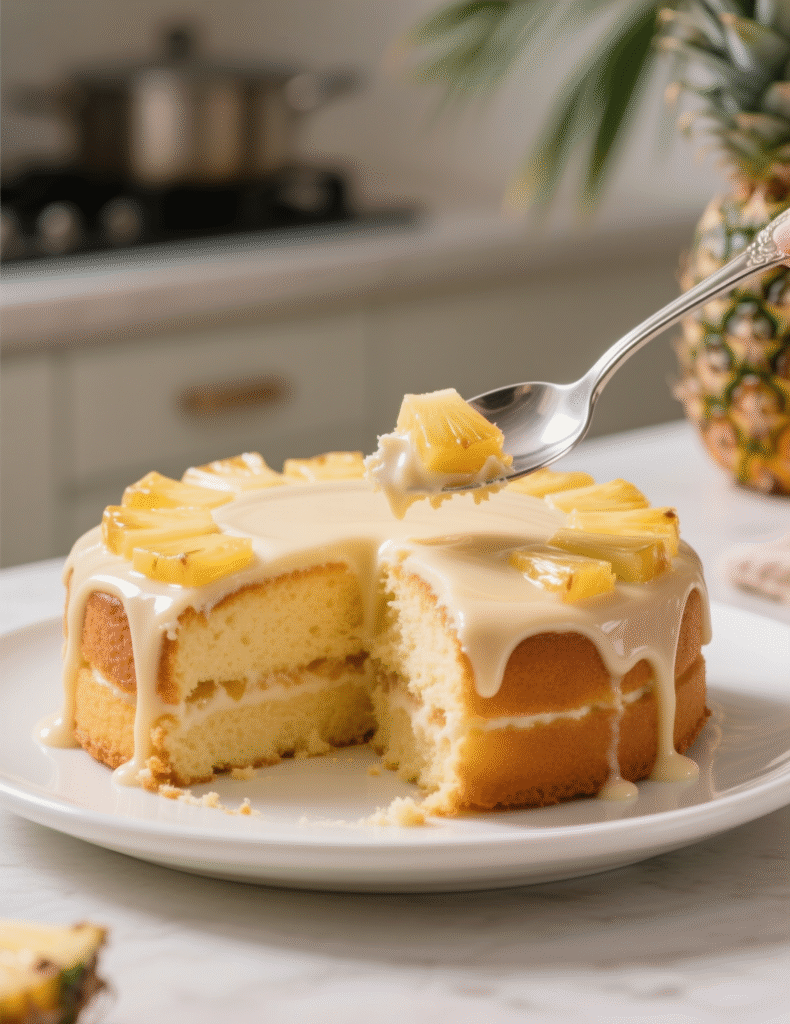A pineapple condensed milk cake isn’t just another sweet dessert—it’s a symphony of tropical brightness and creamy richness that feels almost unfairly decadent. The pineapple brings that sharp-sweet tang, while condensed milk lays down this silky, caramelized depth you can’t fake with anything else. I’m going to break it all down, step by step, but also dig into the science and subtle details professionals never ignore. Because a cake like this, when done properly, doesn’t just taste good—it becomes unforgettable.
Why Pineapple and Condensed Milk Belong Together
The pairing looks almost too obvious. Pineapple’s acidity cuts through the heaviness of sweetened condensed milk. It’s a natural balancing act, one that professional bakers lean on often without saying it out loud. You get brightness and richness in one spoonful.
Condensed milk isn’t just sweetness, it’s about texture. The reduced water and high sugar content change how batters bake. Cakes turn moist, almost pudding-like, but without collapsing. When pineapple joins the mix, enzymes and fibers from the fruit play their role, too. It’s like an unseen dialogue happening inside the oven.
The Role of Pineapple in Cake Science
Fresh pineapple contains bromelain, a proteolytic enzyme that tenderizes proteins. This is good news and bad news. Good news: it softens gluten structure, making crumb more tender. Bad news: left unchecked, it can make batter break down and cake collapse.
That’s why pros rarely throw raw pineapple chunks directly into a delicate cake batter. Instead, they use canned pineapple (where heat processing neutralizes bromelain) or cook down fresh pineapple first. This keeps flavor intact while neutralizing destructive enzymes.
Professional pastry chefs also know pineapple’s acidity interacts with baking soda. A dash of soda in the mix not only neutralizes acidity but also adds lift. This is one of those quiet tricks no one talks about but always uses.
Sweetened Condensed Milk: The Backbone
Sweetened condensed milk isn’t simply “sweet milk.” It’s concentrated milk solids plus sugar cooked down until thick. That structure changes everything in baking.
Its high sugar content caramelizes quickly. That’s why pineapple condensed milk cakes often develop this gorgeous golden-brown crust without needing much added sugar. Condensed milk also brings emulsifying properties. It binds fat and water, creating a smooth crumb even without much butter.
In blind taste tests (I did this once in a professional kitchen), people described condensed milk cakes as “comforting” and “custardy” compared to regular sponge cakes. That’s exactly the appeal here.

Ingredients That Make the Difference
When crafting a pineapple condensed milk cake, precision matters. Here’s what makes or breaks the recipe:
- Pineapple – Canned crushed pineapple works best. It’s consistent in sweetness and acidity. Fresh pineapple must be cooked down.
- Condensed Milk – Always sweetened. Unsweetened condensed milk (evaporated milk) won’t give the same texture or sweetness.
- Flour – All-purpose works fine, but cake flour gives a more delicate crumb.
- Fat – Butter deepens flavor, while neutral oils like canola ensure moistness. Some bakers even blend both.
- Eggs – Room temperature eggs whip better, creating air pockets essential for structure.
- Leavening – A combination of baking powder and a touch of baking soda balances pineapple’s acidity.
Step-by-Step Recipe for Pineapple Condensed Milk Cake
This is a classic version that professionals often tweak depending on context.
Ingredients
- 2 cups all-purpose flour
- 1 tsp baking powder
- ½ tsp baking soda
- ½ tsp salt
- ½ cup unsalted butter (softened)
- ½ cup neutral oil
- ¾ cup granulated sugar
- 3 large eggs
- 1 cup sweetened condensed milk
- 1 cup crushed pineapple (well-drained)
- 1 tsp vanilla extract
Method
- Preheat oven to 350°F (175°C). Grease and flour a 9-inch round or bundt pan.
- Sift flour, baking powder, baking soda, and salt together. This avoids clumps and helps even rising.
- In a large bowl, cream butter, oil, and sugar until pale and fluffy. This step isn’t skippable—it traps air.
- Add eggs one at a time, beating after each. Scrape the bowl’s sides.
- Mix in condensed milk and vanilla until smooth.
- Gently fold in dry ingredients in two batches.
- Stir in pineapple just until combined. Don’t overmix—the fruit will bleed moisture.
- Pour batter into prepared pan. Bake 40–50 minutes until golden and springy. Toothpick should come out with moist crumbs.
- Cool completely before slicing.
What emerges is a cake that’s moist, dense in a luxurious way, but with a light tropical note. Professionals often say it eats like a cross between a pound cake and a tres leches sponge.
Variations Professionals Swear By
Pineapple Upside-Down Twist
Line the pan with caramelized sugar and pineapple rings before pouring batter. The condensed milk ensures the top caramel seeps into the crumb.
Coconut-Pineapple Fusion
Add ½ cup desiccated coconut into the batter. Coconut fat amplifies the tropical profile while condensed milk smooths out graininess.
Chilled Tres Leches Version
Bake cake thinner, poke holes after cooling, and pour over a mixture of condensed milk, evaporated milk, and heavy cream infused with pineapple juice. Chill overnight for maximum soak.

Pineapple Cream Cheese Frosted Layer Cake
Stack two layers with cream cheese frosting blended with pineapple puree. The tang of cream cheese balances condensed milk’s sweetness.
Common Pitfalls and How to Avoid Them
- Cake sinking in the middle – Usually from too much pineapple juice. Always drain pineapple well, even pressing it lightly.
- Rubbery texture – Overmixing after adding flour. Gluten activates fast, so fold gently.
- Too sweet – Using condensed milk and extra sugar without adjustment. Professionals cut sugar by up to 30% compared to regular cakes.
- Wet, soggy bottom – Happens when fruit pieces clump. Dust pineapple with a spoonful of flour before folding in.
Why This Cake Works So Well in Professional Settings
Catering chefs love it because it keeps moist for days. Condensed milk acts as a natural humectant, drawing in and holding moisture. That’s why bakeries often lean on it when they need cakes that won’t dry out on display.
From a flavor standpoint, pineapple condensed milk cake fits both casual and upscale menus. It’s approachable enough for home diners yet complex enough to plate in fine dining. Think: slice topped with brûléed pineapple and coconut tuile. Suddenly, humble cake looks like Michelin dessert.
Pairings and Serving Suggestions
- Coffee or tea – The caramelized sweetness pairs beautifully with black coffee or Darjeeling tea.
- Tropical fruit compote – Mango, passionfruit, and kiwi elevate the tropical vibe.
- Light whipped cream – Keeps the dessert from feeling heavy.
- Toasted nuts – Pecans or macadamias add crunch and contrast.
One quirky but real pairing: aged rum. A small splash over a slice transforms it into something closer to Caribbean rum cake. Professionals often sneak this trick for adult versions.
Health and Nutrition Insights
Not surprisingly, this isn’t diet food. One slice (1/12 of the cake) averages around 280–350 calories depending on fat used. Sugar content is high, though you can swap part of condensed milk with unsweetened Greek yogurt for balance.
Interestingly, pineapple brings vitamin C and manganese, while condensed milk provides calcium. So while indulgent, it’s not empty calories. Some chefs experiment with whole wheat flour blends or coconut sugar to make it slightly healthier.
Emerging Trends in Pineapple Condensed Milk Cakes
Across professional kitchens, tropical-inspired desserts are trending. Pineapple condensed milk cakes show up more in Asian and Latin American bakeries. There’s also a shift toward mini loaf or cupcake versions, as individual servings align with modern dining trends.
Plant-based pastry chefs now use coconut condensed milk and aquafaba eggs to replicate the recipe for vegan markets. Results are surprisingly close in texture. This adaptation is quickly gaining ground in boutique bakeries.
Conclusion: The Tropical Classic That Never Disappoints
Pineapple condensed milk cake is more than the sum of its parts. It’s creamy yet bright, indulgent but balanced. Professionals prize it for its forgiving structure, long shelf life, and adaptability across menus.
If you make it once, you’ll see how effortlessly it pleases crowds. But if you tweak it with intention—balancing acids, fats, and sugars—you end up with a dessert that feels polished, almost like it belongs in fine dining. That’s the beauty of it. A humble cake elevated, not by gimmicks, but by understanding how ingredients talk to each other.
FAQs
Can I use fresh pineapple instead of canned?
Yes, but cook it first to neutralize bromelain, otherwise the cake may collapse.
Why is my pineapple condensed milk cake too soggy?
It usually happens if the pineapple isn’t drained well before mixing.
Do I need both butter and oil in the recipe?
Using both adds flavor from butter and moisture from oil, creating balance.
Can I make this cake without eggs?
Yes, replace eggs with yogurt or flaxseed mix, though texture changes slightly.
How long does pineapple condensed milk cake stay fresh?
It stays moist for up to 3–4 days at room temperature in an airtight container.
Can I reduce the sweetness in this recipe?
Yes, cut back on added sugar since condensed milk already provides plenty.
Why does my cake sink in the middle?
Excess pineapple juice or underbaking often causes the center to sink.
Can I freeze pineapple condensed milk cake?
Yes, wrap slices tightly and freeze for up to 2 months.
Is condensed milk the same as evaporated milk?
No, condensed milk is sweetened and thicker, while evaporated milk is unsweetened.
What’s the best frosting for this cake?
Cream cheese frosting with a touch of pineapple puree balances sweetness perfectly.

Mariana is a passionate home cook who creates delicious, easy-to-follow recipes for busy people. From energizing breakfasts to satisfying dinners and indulgent desserts, her dishes are designed to fuel both your body and hustle.
When she’s not in the kitchen, she’s exploring new flavors and dreaming up her next recipe to share with the Foodie Hustle community.

